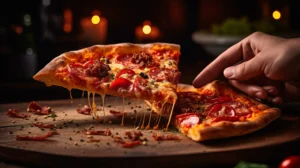Pizza is more than just a dish; it’s a global phenomenon that transcends cultural boundaries and culinary traditions. From its humble beginnings in Naples to its modern-day iterations around the world, pizza has evolved into a beloved staple in households everywhere. Let’s embark on a detailed journey through the history, variations, and the art of making pizza at home.
Origins and Evolution of Pizza
A Taste of Naples: The Birthplace of Pizza Pizza traces its roots back to Naples, Italy, in the late 18th century. Originally a street food for the working class, Neapolitan pizza featured a simple yet delightful combination of flatbread topped with tomatoes, herbs, and cheese. This basic recipe has since blossomed into countless variations, reflecting regional tastes and innovations.
From Naples to New York: The Journey Across the Atlantic As Italian immigrants made their way to the United States in the late 19th and early 20th centuries, they brought their pizza-making traditions with them. New York City quickly became a hub for pizza innovation, giving rise to the iconic New York-style pizza with its thin, foldable crust.
Global Pizza Variations

A World of Flavors: International Takes on Pizza Beyond Italy and the United States, pizza has been embraced and reimagined across the globe:
- Chicago Deep-Dish Pizza: Characterised by its thick crust and layers of cheese, meats, and vegetables, Chicago-style pizza is more of a savoury pie. The crust is buttery and often baked in a deep pan, resulting in a rich, filling meal.
- New York Style Pizza: Known for its large, thin, and foldable slices, New York pizza boasts a crispy yet chewy crust. Typically topped with tomato sauce and mozzarella cheese, it’s a favourite for those on the go.
- Detroit Style Pizza: A rectangular pizza with a thick, crispy crust, Detroit pizza is baked in a well-oiled pan, which gives it a fried bottom. It is traditionally topped with Wisconsin brick cheese and a layer of tomato sauce.
- California Pizza: This style is known for its innovative and non-traditional toppings, like artichokes, avocado, and smoked salmon. It often features a thin crust and is heavily influenced by fresh, local ingredients.
- Neapolitan Pizza: Staying true to its roots, Neapolitan pizza is simple yet flavorful. It features a soft, chewy crust with charred spots from being baked in a wood-fired oven. The toppings are minimalistic, usually just tomatoes, mozzarella, and basil.
- Mexican Pizza: Mexican pizza brings a spicy kick with toppings such as chorizo, jalapeños, refried beans, and queso fresco. It’s often paired with a salsa or crema drizzle, adding a vibrant flavour profile.
- Brazilian Pizza: Unique toppings like chocolate, bananas, and condensed milk make Brazilian pizzas a delightful surprise. Savoury options include toppings like catupiry cheese and heart of palm.
- Japanese Pizza: Japanese pizzas might feature unconventional ingredients like squid, mayonnaise, seaweed, and teriyaki chicken. The flavours are often bold and umami-rich, reflecting Japanese culinary traditions.
The Art of Pizza Making at Home
Mastering the Dough: The Foundation of Great Pizza The key to an excellent pizza lies in the dough. The perfect balance of flour, water, yeast, and salt creates a canvas for a variety of toppings. Here are some tips for making pizza dough at home:
- Ingredients: Use high-quality flour, preferably Italian “00” flour for a soft and stretchy dough.
- Fermentation: Allow the dough to ferment for at least 24 hours in the refrigerator. This slow fermentation process enhances flavour and texture.
- Kneading: Knead the dough until it’s smooth and elastic. This helps develop gluten, giving the dough its characteristic chewiness.
Choosing the Right Toppings: Balancing Tradition and Innovation While traditional toppings like mozzarella, tomatoes, and basil remain favourites, don’t be afraid to experiment. Modern trends include:
- Plant-Based Options: Incorporate plant-based cheeses and proteins for a vegan-friendly pizza.
- Gourmet Ingredients: Try unique cheeses like gorgonzola or toppings like truffle oil for a gourmet twist.
- Healthy Alternatives: Use whole grain or cauliflower crusts for a healthier base.
Making the Perfect Sauce: Enhancing the Flavor A good pizza sauce can elevate your homemade pizza to new heights. Here are some popular options:
- Classic Tomato Sauce: Made from San Marzano tomatoes, garlic, olive oil, and fresh basil. Simmer until thick and flavorful.
- White Sauce: A creamy base made from a blend of ricotta, mozzarella, Parmesan cheese, and garlic. Perfect for those who prefer a milder, richer flavour.
- Pesto Sauce: A vibrant green sauce made from fresh basil, pine nuts, Parmesan cheese, and olive oil. Adds a burst of freshness to any pizza.
Pizza as a Cultural and Social Experience
A Meal to Share: Pizza’s Role in Bringing People Together Pizza is more than just food; it’s an experience that fosters connection. Whether you’re hosting a pizza night with friends or enjoying a quiet family dinner, the act of making and sharing pizza creates lasting memories.
Pizza in Pop Culture: An Iconic Presence From movies like “Home Alone” to viral internet memes, pizza holds a special place in popular culture. Its ubiquitous presence reinforces its role as a comfort food that resonates with people of all ages.
Embracing Technology in Home Pizza Making
The Digital Age: Modern Convenience Meets Tradition Today’s digital age has made ordering and making pizza easier than ever. Online platforms and delivery apps allow you to customise your pizza and have it delivered right to your doorstep. For home chefs, new technologies like automated dough kneaders and smart ovens make the pizza-making process more accessible and efficient.
Looking to the Future: Innovations in Pizza As technology continues to advance, so too does the world of pizza. Imagine drones delivering hot, fresh pizza to your home or AI-powered kitchen gadgets helping you perfect your dough. The future of pizza is bright and full of possibilities.
Conclusion
The pizza edition at home is not just about recreating a beloved dish; it’s about embracing a culinary tradition that spans continents and cultures. From mastering the art of dough-making to experimenting with global flavours, making pizza at home is a delightful journey. Whether you stick to the classics or venture into new territory with innovative toppings, pizza will always hold a special place in our hearts and kitchens.
FAQs
Is pizza initially from Italy?
Indeed, pizza started in Naples, Italy, in the late eighteenth hundred years.
What topping is used most frequently on pizza?
Pepperoni is reliably positioned as the most famous pizza besting around the world.
Might pizza at any point be sound?
Absolutely, provided the crust is composed primarily of nutritious grains, lean meats, and enough of vegetables, pizza can be included in a balanced diet.
How can one create the ideal pizza crust?
Legitimate mixture maturation and excellent flour are critical to accomplishing a delightful and breezy outside layer.
For what reason is pizza a particularly dearest food around the world?
Pizza’s widespread popularity can be attributed to its adaptability, reassuring nature, and appeal to groups.
















+ There are no comments
Add yours